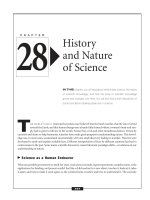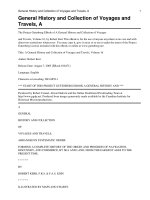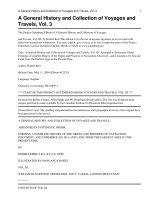History and Nature of Science
Bạn đang xem bản rút gọn của tài liệu. Xem và tải ngay bản đầy đủ của tài liệu tại đây (117.11 KB, 8 trang )
T
HE WORLD
’
S MOST
renowned scientists once believed that the Earth was flat, that the sun revolved
around the Earth, and that human beings were already fully formed within a woman’s body and sim-
ply had to grow to full size in the womb. Science has a rich and often tumultuous history. Driven by
curiosity and desire to help humanity, scientists have made great progress in understanding nature. This knowl-
edge was, in most cases, accumulated incrementally, with one small discovery leading to another. Theories were
developed to unify and explain available facts. Different interpretation of facts by different scientists has lead to
controversies in the past. Some major scientific discoveries created dramatic paradigm shifts—revolutions in our
understanding of nature.
Science as a Human Endeavor
What can possibly get someone to study for years, read science journals, repeat experiments countless times, write
applications for funding, and present results? Just like a child reaches for a new object, touches it, looks at it, takes
it apart, and tries to make it work again, so the scientist looks at nature and tries to understand it. The curiosity
CHAPTER
History
and Nature
of Science
IN THIS chapter, you will read about what drives science, the nature
of scientific knowledge, and how the body of scientific knowledge
grows and changes over time. You will also find a brief description of
some foundation-shaking advances in science.
28
257
almost seems to be innate, and the thrill that comes from
understanding nature or making a new experiment work
is well expressed in the following quote:
“I do not think there is any thrill that can go through the
human heart like that felt by the inventor as he sees some
creation of the brain unfolding to success ...Such emotions
make a man forget food, sleep, friends, love, everything.”
—Nikola Tesla, physicist and inventor
Scientists are driven by curiosity and the thrill that
comes from understanding or creating something. At the
same time, they are motivated by the desire to improve the
quality of life—making everyday chores easier, curing
diseases, and solving global and environmental prob-
lems. Scientists also seek to use, predict, and control
nature—to use sunlight and water for electrical power
generation, to forecast the weather and earthquakes, to
prevent floods, and to prevent infection of crops and
cattle.
The result is that over the years, our understanding of
science has greatly improved. Humanity has gone from
attributing disease to supernatural beings to developing
vaccines, antibiotics, and gene therapy to prevent and
cure disease. Since Thales of Miletus proposed in 625
B
.
C
.
that the Earth is a disc that floats on water, humans have
discovered the true nature of their planet, have observed
other galaxies, and have landed on the moon. The im-
mense progress people have made in science is well
expressed in this quote:
“The simplest schoolboy is now familiar with truths for
which Archimedes would have sacrificed his life.”
—Ernest Renan, philosopher
The Nature of Scientific
Knowledge
Scientific knowledge is rooted in factual information that
is compiled and interpreted to develop theories. While
scientists can’t help believing and hoping—that their
experiments or inventions will work; that they will solve
a problem; that their theories are correct—experiments
are designed to eliminate, as much as possible, the effects
of the beliefs and hopes of the scientist performing them.
Different scientists often get conflicting data. Even the
same scientist’s data is not always consistent. Differences
in experimental procedure, which the scientists may or
may not be aware of, can all lead different scientists to
different conclusions or even the same scientist to dif-
ferent conclusions at two different times. Occasionally,
this leads to controversy. In the sections below, we will
briefly describe the nature of scientific knowledge and
how beliefs and controversies play a part.
Facts
Scientific knowledge is dependent and inseparable from
facts. The principles of the scientific method guide sci-
entists to observe facts and to propose hypotheses that
can be tested by observing other facts. A hypothesis that
can’t be verified by collecting scientific facts is not con-
sidered part of the domain of science.
Theories
Just as a collection of bricks does not equal a house, a col-
lection of facts does not equal science. Scientific facts,
like bricks, need to be sorted and stacked properly. Their
relationships to each other matter and need to be estab-
lished. Scientists must be able to envision the end result,
the way an architect needs to have an idea of what a
house should look like. For scientists, the house is the
theory—something that unites the facts and makes them
meaningful and useful. Theories are formed when a con-
nection between facts is first observed. The theories are
then developed by looking for more facts that fit into the
theory and by modifying the theory to include or explain
the facts that do not fit.
Beliefs
One of the most difficult tasks of a scientist is to remain
objective and prevent beliefs from affecting observations.
This is not to say that scientists purposely hide facts that
don’t support their hypotheses or that are in conflict with
their beliefs. Most scientists are well trained to report
everything they observe, even if it’s inconsistent with
what was previously observed and even if it seems unim-
portant. However, it is in human nature to notice and
remember the things that we believe in and that we
expect.
This is a form of intellectual prejudice. If Bob
believes that Julie hates him, he will tend to notice only
Julie’s negative behavior toward him such as not saying
–
HISTORY AND NATURE OF SCIENCE
–
258
hello and making a joke about him. He will also tend to
interpret Julie’s actions in a negative way. For example, if
Julie says that she can’t go to the movies, Bob will take
that as evidence for his hypothesis that Julie hates him.
However, this is not necessarily true—Julie may have too
much homework. Bob could also disregard or misinter-
pret the nice things that Julie does—it could be a coinci-
dence that Julie sat next to him and that she called him
(maybe she just needed something). Scientists can’t help
but occasionally do the same thing. For example, a sci-
entist who smokes may note the great number of people
who smoke and don’t get cancer, and attribute the fact
that some people who smoke and do get cancer to pol-
lution sensitivity or lack of proper nutrition.
Marie Curie, a two-time Nobel Prize winner, refused
to note overwhelming data that suggested that radium,
an element she had discovered, was a health hazard. This
inability to see was not caused by lack of training, as
Curie was a sufficiently trained scientist whose doctoral
thesis was considered the greatest single contribution to
science by a doctoral student. The inability to see is
caused by a blindfold made of hopes and beliefs that
scientists, like all other people, can’t help having once in
a while.
“Man can’t help hoping even if he’s a scientist. He can
only hope more accurately.”
—Karl Menninger, psychiatrist
Controversies
Conflicting data, or facts that seemingly can’t be incor-
porated into the same theory, often cause controversies
among scientists. The controversies can polarize the sci-
entific community, as well as the general population,
especially in matters of public or social importance. In
the past, controversies also sprang up between scientists
and religious establishments. Copernicus shook up the
church when he proposed that planets revolved around
the sun. Similarly, Darwin caused a lot of controversy
when he presented his theory of evolution. There is still
some debate on whether evolution theory should be
taught in public schools.
The nature of light was not very well understood for
a long time. There were observations that suggested that
light is a stream of particles, as well as that light is a wave.
Newton’s belief that light was a series of particles pre-
vailed from the 1700s until 1873, when James Clerk
Maxwell showed that light is an electromagnetic
phenomenon. Although many scientists before Maxwell
found evidence for the wave nature of light, Newton’s
great reputation and social class allowed his ideas to pre-
vail until there was enough evidence to the contrary. Max
Planck’s theory about the resolution of controversies is
slightly more cynical:
“A new scientific truth does not triumph by convincing
its opponents and making them see the light, but rather
because its opponents eventually die, and a new genera-
tion grows up that is familiar with it.”
—Max Planck, physicist
Historical Perspectives
All sciences are rooted in philosophy, which they
stemmed from, as knowledge in different sciences accu-
mulated and became more specialized. Areas of science
today include very specific subjects, such as oceanogra-
phy, crystallography, and genetic engineering, as well as
interdisciplinary subjects, such as biochemistry and bio-
physics.
Progress in science usually occurs in small incremen-
tal steps. For example, nucleic acids (building blocks of
DNA) were discovered in the nuclei of cells in 1869. After
that, progress was made. Different scientists made con-
tributions to the study of DNA. However, scientists did
not solve the structure of DNA until 1953, when Ros-
alind Franklin, James Watson, and Francis Crick
obtained their results. About twenty years later, the first
genome sequencing was presented—for a virus that had
a relatively small amount of genetic material. More
recently, the Human Genome Project was completed.
Hundreds of scientists worked on this largest single fed-
erally funded project to date with the goal of identifying
all human genes and mapping out the human DNA. Sci-
entific advances usually depend on other scientific
advances, and progress is usually gradual. Many scien-
tists put in a lot of time before a new concept becomes
completely understood and before a new area of science
develops.
Occasionally, however, there are leaps in scientific
progress. Such leaps represent major discoveries that
–
HISTORY AND NATURE OF SCIENCE
–
259
shake the foundations of understanding and lead to new
modes of thinking. Thomas Kuhn, philosopher of sci-
ence, called such discoveries paradigm shifts.
Here are some major advances in science.
■
420
B
.
C
.: Hippocrates begins the scientific study
of medicine by maintaining that diseases have
common causes.
■
260
B
.
C
.: Archimedes discovers the principle of
buoyancy.
■
180
A
.
D
.: Galen studies the connection between
paralysis and severance of the spinal cord.
■
1473: Copernicus proposes a heliocentric system.
■
1581: Galileo finds that objects fall with the same
acceleration.
■
1611: Kepler discovers total internal reflection
and thin lens optics.
■
1620: Francis Bacon discusses the principles of
the scientific method.
■
1687: Newton formulates the laws of gravity.
■
1789: Lavoisier states the law of conservation of
energy.
■
1837: Darwin uses natural selection to explain
evolution.
■
1864: James Clerk Maxwell shows that light is an
electromagnetic phenomenon.
–
HISTORY AND NATURE OF SCIENCE
–
260
N
OW THAT YOU
have reviewed the information you need to know, it’s time to think about strate-
gies you can use at test time. Throughout this chapter, you will review the structure of the science
exam and learn specific tips you can use to improve your score on the test. Read this chapter care-
fully, and then review your notes from the science section. When you are ready, move on to the practice ques-
tions that follow.
Multiple-Choice Questions
The good thing about multiple-choice questions is that the answer is right in front of you. All you need to do is
find it, or at least eliminate some of the clearly wrong choices.
At times, you may not be able to eliminate all four of the incorrect choices. But there is no penalty for guess-
ing on the GED. If you can eliminate one of the wrong choices, you will have a 25% chance of guessing correctly,
and that is still better than leaving it blank. If you can eliminate three choices, you have a 50% chance of getting
the question right.
When answering multiple-choice questions, make sure you have read the question carefully. Often, the ques-
tion will ask you to chose a statement that is NOT true or find an exception to the rule.
CHAPTER
Tips and
Strategies
for the GED
Science Exam
IN THIS chapter, you will briefly review some tips you can use on the
GED Science Exam. Several tips apply to other sections of the GED
as well.
29
261









